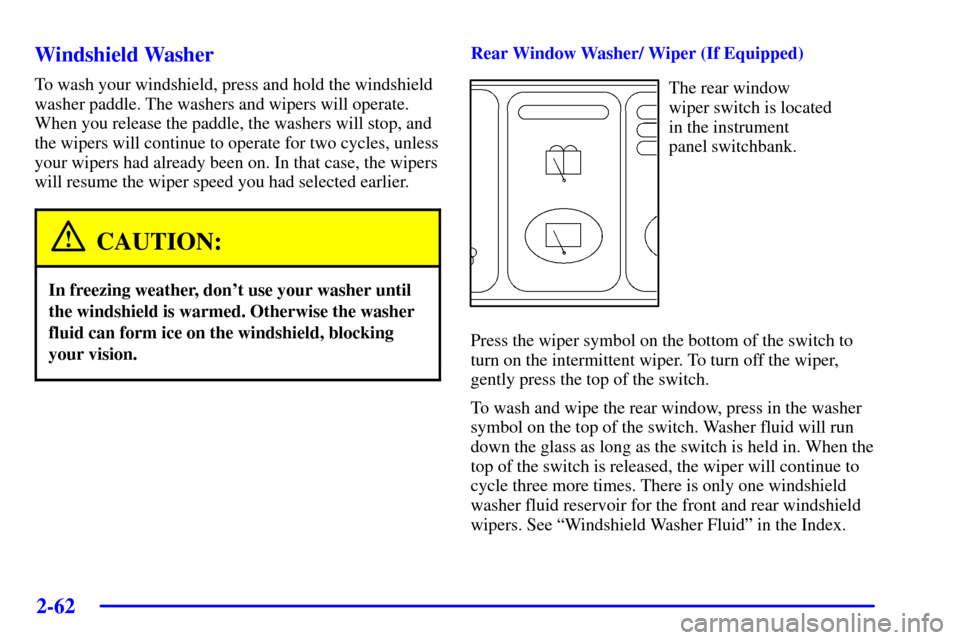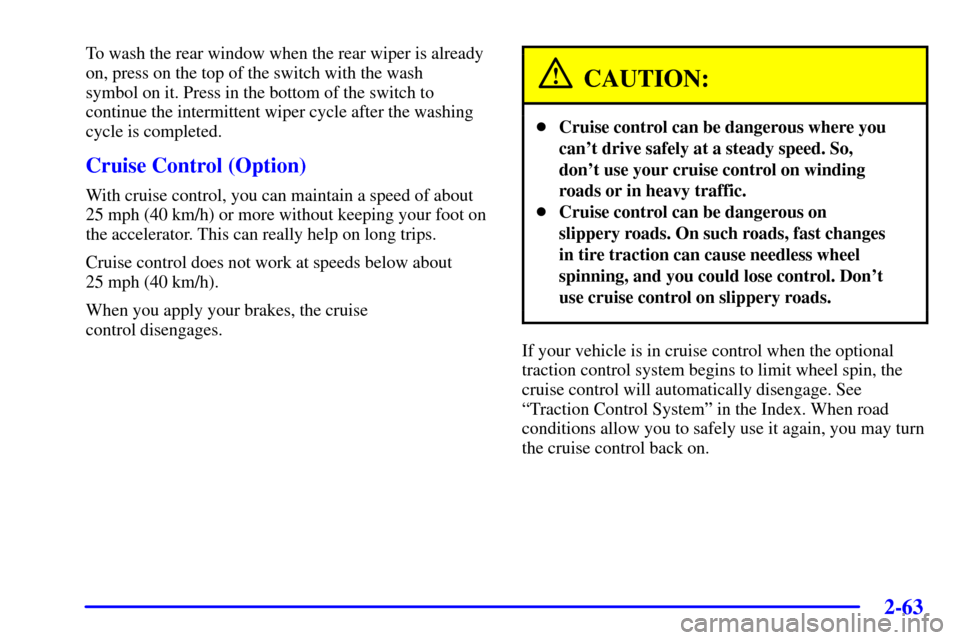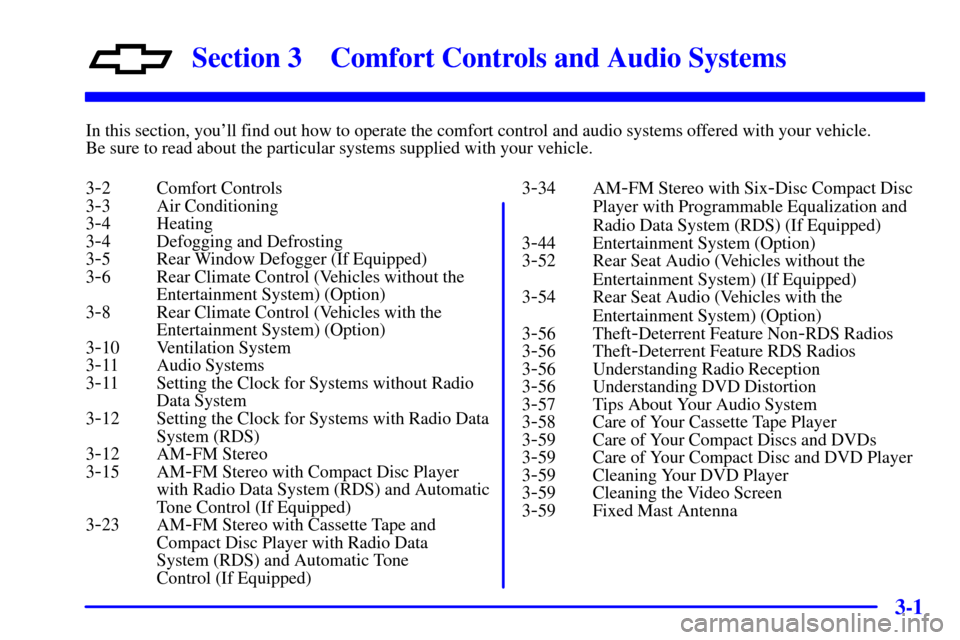Page 165 of 486
2-57
Parking Over Things That Burn
CAUTION:
Things that can burn could touch hot exhaust
parts under your vehicle and ignite. Don't park
over papers, leaves, dry grass or other things that
can burn.
Engine Exhaust
CAUTION:
Engine exhaust can kill. It contains the gas
carbon monoxide (CO), which you can't see or
smell. It can cause unconsciousness and death.
You might have exhaust coming in if:
�Your exhaust system sounds strange
or different.
�Your vehicle gets rusty underneath.
�Your vehicle was damaged in a collision.
�Your vehicle was damaged when driving over
high points on the road or over road debris.
�Repairs weren't done correctly.
�Your vehicle or exhaust system had been
modified improperly.
If you ever suspect exhaust is coming into
your vehicle:
�Drive it only with all the windows down to
blow out any CO; and
�Have your vehicle fixed immediately.
Page 170 of 486

2-62 Windshield Washer
To wash your windshield, press and hold the windshield
washer paddle. The washers and wipers will operate.
When you release the paddle, the washers will stop, and
the wipers will continue to operate for two cycles, unless
your wipers had already been on. In that case, the wipers
will resume the wiper speed you had selected earlier.
CAUTION:
In freezing weather, don't use your washer until
the windshield is warmed. Otherwise the washer
fluid can form ice on the windshield, blocking
your vision.
Rear Window Washer/ Wiper (If Equipped)
The rear window
wiper switch is located
in the instrument
panel switchbank.
Press the wiper symbol on the bottom of the switch to
turn on the intermittent wiper. To turn off the wiper,
gently press the top of the switch.
To wash and wipe the rear window, press in the washer
symbol on the top of the switch. Washer fluid will run
down the glass as long as the switch is held in. When the
top of the switch is released, the wiper will continue to
cycle three more times. There is only one windshield
washer fluid reservoir for the front and rear windshield
wipers. See ªWindshield Washer Fluidº in the Index.
Page 171 of 486

2-63
To wash the rear window when the rear wiper is already
on, press on the top of the switch with the wash
symbol on it. Press in the bottom of the switch to
continue the intermittent wiper cycle after the washing
cycle is completed.
Cruise Control (Option)
With cruise control, you can maintain a speed of about
25 mph (40 km/h) or more without keeping your foot on
the accelerator. This can really help on long trips.
Cruise control does not work at speeds below about
25 mph (40 km/h).
When you apply your brakes, the cruise
control disengages.
CAUTION:
�Cruise control can be dangerous where you
can't drive safely at a steady speed. So,
don't use your cruise control on winding
roads or in heavy traffic.
�Cruise control can be dangerous on
slippery roads. On such roads, fast changes
in tire traction can cause needless wheel
spinning, and you could lose control. Don't
use cruise control on slippery roads.
If your vehicle is in cruise control when the optional
traction control system begins to limit wheel spin, the
cruise control will automatically disengage. See
ªTraction Control Systemº in the Index. When road
conditions allow you to safely use it again, you may turn
the cruise control back on.
Page 182 of 486
2-74 Convex Outside Mirror
Your passenger's side mirror is convex. A convex
mirror's surface is curved so you can see more from the
driver's seat.
CAUTION:
A convex mirror can make things (like other
vehicles) look farther away than they really are.
If you cut too sharply into the right lane, you
could hit a vehicle on your right. Check your
inside mirror or glance over your shoulder before
changing lanes.
Heated Outside Mirrors (If Equipped)
The outside rearview mirrors are heated when you
activate the rear window defogger. See ªRear Window
Defoggerº in the Index.
Storage Compartments
Your vehicle's large carrying capacity can store many
items. If you have the extended wheelbase version, you
can carry things as large as a 4� x 8� piece of plywood.
You can also use the floor pins that are used to attach the
seats, to secure larger loads.
Page 209 of 486

2-101
Speedometer and Tamper
Resistant Odometer
Your speedometer lets you see your speed in both miles
per hour (mph) and kilometers per hour (km/h). Your
odometer shows how far your vehicle has been driven,
in either miles (used in the United States) or kilometers
(used in Canada).
Your vehicle has a tamper
-resistant odometer.
You may wonder what happens if your vehicle needs a
new odometer installed. If the new one can be set to the
mileage total of the old odometer, then that will be done.
If it can't, then it's set at zero and a label must be put on
the driver's door to show the old mileage reading when
the new odometer was installed.
Dual Trip Odometers
In addition to the standard odometer, the cluster can also
display two separate trip odometers (designated by the
letter A or B in the display window) as well as your
vehicle's Engine Oil Life (designated by the word OIL
in the display window). The display can be toggled
between the odometer, the trip odometers and engine
oil life by quickly pressing and releasing the trip/reset
button located to the right of the temperature gage.
The display toggles once each time the trip/reset button
is pressed for less than 1.5 seconds. The display toggles
in the following sequence: Odometer
- Trip
Odometer A
- Trip Odometer B - Engine Oil Life.
If the engine oil life is left on the display, it will
automatically toggle back to the odometer after
approximately 15 seconds. Each of the two trip
odometers can be used to keep track of different trip
distances (for example, the mileage of a long trip
and the mileage driven on the current tank of fuel).
The trip odometers will continue to keep track of miles
(kilometers) driven even if they are not currently
displayed. To reset the odometer to zero (0), press and
hold the trip/reset button for at least 1.5 seconds, but less
than three seconds. Only the trip odometer that is
showing in the display will be reset.
Page 231 of 486

2-123
Resetting the Trip Computer
Press and hold the MODE and E/M buttons for at least
two seconds. The reset is acknowledged with the display
showing all segments on briefly. A reset can only be
done in AVG ECON, FUEL USED and AVG SPEED
displays. AVG ECON, FUEL USED and AVG SPEED
can be reset independently. Only the mode that is
displayed will be reset.
Rear Parking Assist (Option)
Rear parking assist can help you to determine how close
an object is to your rear bumper within a given area,
making parking easier. It is not intended to be used
primarily as a rear obstacle detection system.
The rear parking assist display is located inside the
vehicle, above the rear window. It has three color
-coded
lights that can be seen through the rearview mirror.
The rear PARK AID switch
is located in the overhead
console switchbank.
Rear parking assist can be disabled by pressing the
part of the switch with the PARK AID disable symbol
on it. Pressing the textured part of the switch enables
the system.
Page 233 of 486

3-
3-1
Section 3 Comfort Controls and Audio Systems
In this section, you'll find out how to operate the comfort control and audio systems offered with your vehicle.
Be sure to read about the particular systems supplied with your vehicle.
3
-2 Comfort Controls
3-3 Air Conditioning
3-4 Heating
3-4 Defogging and Defrosting
3-5 Rear Window Defogger (If Equipped)
3-6 Rear Climate Control (Vehicles without the
Entertainment System) (Option)
3
-8 Rear Climate Control (Vehicles with the
Entertainment System) (Option)
3
-10 Ventilation System
3-11 Audio Systems
3-11 Setting the Clock for Systems without Radio
Data System
3
-12 Setting the Clock for Systems with Radio Data
System (RDS)
3
-12 AM-FM Stereo
3-15 AM-FM Stereo with Compact Disc Player
with Radio Data System (RDS) and Automatic
Tone Control (If Equipped)
3
-23 AM-FM Stereo with Cassette Tape and
Compact Disc Player with Radio Data
System (RDS) and Automatic Tone
Control (If Equipped)3
-34 AM-FM Stereo with Six-Disc Compact Disc
Player with Programmable Equalization and
Radio Data System (RDS) (If Equipped)
3
-44 Entertainment System (Option)
3-52 Rear Seat Audio (Vehicles without the
Entertainment System) (If Equipped)
3
-54 Rear Seat Audio (Vehicles with the
Entertainment System) (Option)
3
-56 Theft-Deterrent Feature Non-RDS Radios
3-56 Theft-Deterrent Feature RDS Radios
3-56 Understanding Radio Reception
3-56 Understanding DVD Distortion
3-57 Tips About Your Audio System
3-58 Care of Your Cassette Tape Player
3-59 Care of Your Compact Discs and DVDs
3-59 Care of Your Compact Disc and DVD Player
3-59 Cleaning Your DVD Player
3-59 Cleaning the Video Screen
3-59 Fixed Mast Antenna
Page 235 of 486

3-3
(Defog): This setting directs air to the windshield
and through the floor ducts. This mode is useful during
cold or inclement weather because of your vehicle's
larger windshield area.
(Defrost): This setting directs most of the air to the
windshield and side window vents.
Mode Buttons
(Outside Air): Press this button to send outside
air into your vehicle. The light in the button will glow
when outside air is in use. Using this setting while trying
to defrost or defog the windows will help clear the vents
of moisture. While floor, defog or defrost mode is
selected, the system will automatically go to outside
air mode.
(Recirculation): Press this button to limit the
amount of outside air entering your vehicle. The light in
the button will glow when outside air is in use. You may
use this setting to limit odors entering your vehicle.
Operating the Heating/Ventilation/Air Conditioning
(HVAC) system in the recirculation mode may cause
fogging of the vehicle's windows when the weather iscold and damp. To clear the fog, switch the HVAC
system to either the defog or defrost mode and increase
the fan speed. To avoid re
-fogging of the windows,
operate the HVAC system in the outside air mode.
A/C (Air Conditioning): Press this button to turn
the air conditioning compressor on and off. The light in
the button will glow when the air conditioning is in use.
Air Conditioning
On very hot days, your vehicle will cool down more
quickly and economically if you open the windows long
enough to let hot, inside air escape. For all settings,
adjust the temperature control knob and fan speed
as desired.
To get maximum cooling or a quick cool
-down on
very hot days, press the A/C and recirculation buttons
and turn the temperature knob counterclockwise toward
the blue area. Adjust the mode knob to direct the air to
the desired location. This setting should not be used for
long periods of time because the air may become too
cold and dry. Push the A/C button again the to turn off
the air conditioning.